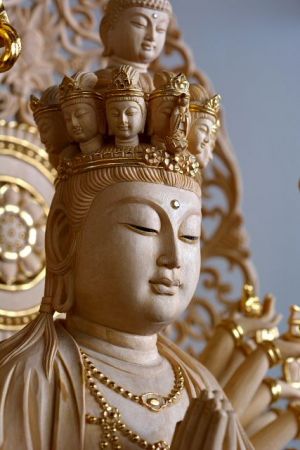Yogacara & the eight consciousnesses
In Mahayana Buddhism, the Mind-only school states that consciousness alone exists and that everything you see or feel is just an illusion of the mind. Therefore, everything’s true nature is emptiness, except the mind. However, if the appearance of our world is only projected through one’s mind, then why would the mind find the need to project false illusions in the first place? Why does it lead us to believe there is an “I”? Vasubandhu explains by saying consciousness is dependent on sensation.
To get a better understanding of this, we must look at the eight kinds of consciousness in Yogacara. The first five are the senses of seeing, hearing, smelling, tasting, and touching. And in order to have these senses we need our organs: eyes, ears, nose, tongue, and skin. The six consciousness is the mind. Here, the mind gets treated as just another sensory organ. As it takes in sensory information, it reflexively interprets emotions and thoughts, derived by the sense of ego. For example, when you perceive a piece of chocolate cake, either by sight, smell, or taste this is the part of the mind that says, “this is chocolate cake”. Though, this is interesting because that means the sense conscious realms only exists when you are perceiving something through the senses. If you’re not eating the cake, you’re not tasting anything. If you don’t see it, the mind consciousness also doesn’t exist.
Since the six realms of consciousness above are all based on direct perceptions, they are all temporary. Yogacara believes that there is another layer to the mind that retains long-term impressions, causing a sense of continuity. Otherwise known as manas, this inherent part of the mind overlaps with the mind consciousness, creating the concept of the Self. As a result, we interpret reality in a self centered way, giving way to selfishness, greed and ignorance. These personality traits are the seeds that generate attachments, karma, and continue the cycle of samsara.
In order to truly create a sense of self, the manas depends on the experiences accumulated in the the deepest level of consciousness. The “store-consciousness” is the most fundamental part of the mind that stores the perceptions of every experience we’ve ever had. As, D’amto said, “It is actually the store consciousness that is bound to itself…that is at the root of both the subjective aspect of experience and the experience of objects” Each experience becomes the foundation that generates one’s sense of self and their view of the world.
But of course, in Buddhism, there is no permanent self. In Yogacara, true knowledge begins when consciousness ends. With the eight consciousnesses, it definitely strengthens my understanding that we are just a sum of our experiences. But this brings me back to the view that all phenomena are interconnected and empty of an intrinsic self. I agree with Candrakirti, that if the mind relies on external phenomena to exist, then how can it be bound to itself? As MSA/Bh says, “the doctrines of representation-only and mind-only are not to be understood as ultimately valid, since in the end the goal is to realize that even mind does not exist” (D’amto 204). For me, it is easier to accept that Mind-Only is just a tool to detach from the self in order to understand the higher nature of emptiness.
D’Amato, M. “Three Natures, Three Stages: An Interpretation of the Yogācāra Trisvabhāva-Theory.” Journal of Indian Philosophy 33.2 (2005): 185-207. Web.
Source
